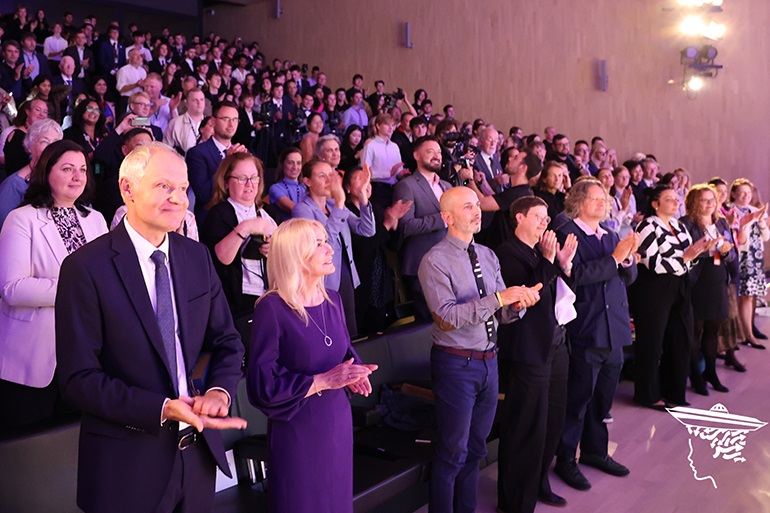Start - Aktualności - The best of the best – we know the winners of EUCYS 2024!

The best of the best – we know the winners of EUCYS 2024!
Behind us is the final struggle of promising young scientists from all over the world as part of the competition European Union Contest for Young Scientist 2024 (EUCYS). During the award ceremony, which took place on the13th September in the Silesian Museum, the European Union awards were granted.
Among the awards there was also a special award of the Silesian University of Technology.
The competition was attended by 143 talented pupils and students aged 14 to 20 from 37 EU countries and beyond. On September 10th -12th, at the NOSPR headquarters, we could see their unique projects responding to the most important challenges of the modern world.
The first prizes of seven thousand Euros each were awarded to:
- Lamia Music from Austria for the project “Sustainable and Advanced Approaches to Dye-sensitized Solar Cells” – the aim of the study was to provide a comprehensive view both on the current development of dye-sensitized solar cells and on future technologies, as well as to assess the importance of each parameter in relation to the overall energy conversion efficiency.
- Nikhil Vemuri from the USA for the project “Anomaly: A Real-Time Globalized System for Effective Regional Mitigation of Agricultural Nitrous Oxide Emissions - the system developed as part of this project identifies real-time nitrous oxide (N2O) emissions worldwide, enabling a rapid reduction in total emissions.
- Piotr Olbryś from Poland for the project “Design of new pyrene-4.5,9.10-tetraone-based heterocyclic derivatives as high-capacity organic cathode materials: A density functional theory study” – the author has designed new derivatives of PTO materials and examined their properties that can serve as a basis for creating a new generation of ecological batteries.
- Aleksandra Petkova from Bulgaria for the project “Theoretical and Experimental Investigation of Ship Wakes” – the initiative allowed to re-examine the formation and characteristics of undulating ships and formulate a new theory on the angles of awakening.
The second prizes of five thousand Euro each were awarded to:
- Seán O’Sullivan from Ireland for the project “VerifyMe: A new approach to authorship attribution in the post-ChatGPT era” – a program that allows to distinguish between human-written text and artificial intelligence-generated content using an innovative stylometry-based author verification system.
- Adam Kovalcik from Slovakia for the project “Design and synthesis of new green furan-based hexynthetic perfumery compounds derived from agricultural waste” – the development of a new ecological industrial process for the production of furfural without waste, allowing to achieve a reduction of CO2 emissions by up to 2400%.
- Leon Verreijt from the Netherlands for his project “Designing, building, and testing a multi-wire proportional chamber ”– a study describing the development of a homemade Multi-Wire Proportional Chamber (MWPC) – a detector that can collect data from ionizing particles.
- Ann Wang of Canada for the project “Eradicating Cystic Fibrosis Biofilms by a Novel Non-Toxic, Multi-Pathway Salicylate Therapy ” – a study focusing on the use of salicylates (such as aspirin) to reduce the growth of cystic fibrosis biofilm.
The third prizes of 3.5 thousand euro each were awarded to:
- Angela Cao from Canada for the project “S2S: AI-Powered Translation Between Sign and Spoken Languages, an initiative designed for hearing loss sufferers, proposes an innovative SLT model that allows users to translate ASL and spoken English by developing and fine-tuning a number of large language and statistical models.
- Nicolas Dominic Huber from Switzerland for the project “Pushing the Limits – Active Safety in Paragliding” – the initiative presents a comprehensive approach to increasing the safety of paragliders in flight based on new numerical models of specific situations in airspace.
- Kamilė Milkintaitė from Lithuania for the project “Towards improved Brain Tumour Treatment: Novel Therapeutic and Diagnostic Targets” – a study aimed at improving outcomes of glioma patients by identifying new biomarkers of glioma for gene therapy and early diagnosis, while also investigating their molecular mechanisms.
- Márton Krisztián Hegedűs from Hungary for the project “Photocatenane – Robotics on the Molecular Level” – research focusing on the photo responsive supramolecular unit, specifically on the photo functionalized catenan.

In turn, the Special Jury Prize was awarded to:
- Ido Somekh and Leonardo Magnani from Luxembourg for the AllergyScan project – a system designed for people with food allergies and their families that uses QR codes on food packaging to provide immediate allergen information via a transparent mobile app and thus simplifies the process of understanding product labels.
Among the awards presented were also university awards of the Academic Consortium – Katowice City of Science.
The Special Award of the Silesian University of Technology was given to Ediz Osman from Germany for the project: “Pioneering the Development of a Carbon-Free VTOL Jet for Civil Aviation.”
The aim of the project is to develop a zero-emission jet capable of vertical take-off and landing (VTOL). The winner will take a week of internship in a selected unit of the Silesian University of Technology under the supervision of a mentor.
More about the project at: Project: Pioneering the Development of a Carbon-Free VTOL Jet for Civil Aviation - EUCYS Katowice 2024.








